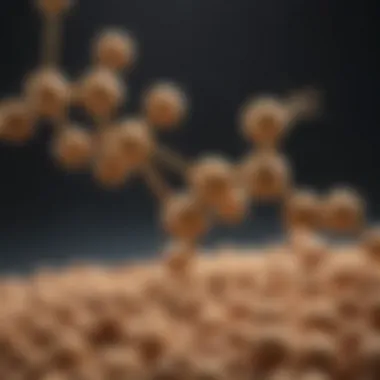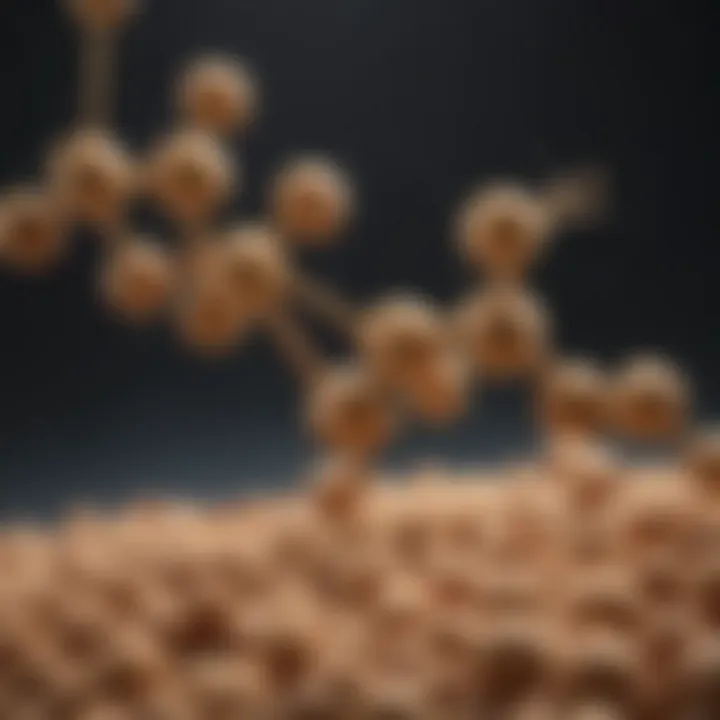Soybeans and Cancer: A Comprehensive Analysis


Intro
The link between diet and health has been the source of extensive research, particularly when examining specific foods and their implications for disease. When it comes to soybeans, an oilseed rich in protein and considered a key dietary staple in various cultures, this inquiry becomes even more nuanced. With increasing frequency, conversations about soy consumption are intertwined with discussions about cancer risk, leading to an important question: Are soybeans a friend or foe in the context of cancer?
Through thorough investigation, various studies have revealed that soy contains compounds known as isoflavones, which have gained attention for their potential role in cancer prevention or promotion. These aspects warrant a closer look to understand not only the scientific evidence but also the cultural and dietary patterns that influence soybean consumption across different populations.
In the following sections, we will explore the research overview that can help elucidate the intricate relationship between soy and cancer. Furthermore, we’ll consider current trends in science and their implications, providing insights valuable for students, researchers, educators, and professionals alike. This synthesis aims to inform and equip readers with a balanced perspective on including soy in a health-conscious diet.
Foreword to Soybeans and Their Nutritional Profile
The significance of understanding soybeans and their nutritional profile cannot be overstated in the context of contemporary health discussions, particularly when exploring their potential role in cancer prevention. As consumers increasingly seek out plant-based alternatives within their diets, soybeans have emerged as a prominent player, not merely as a food source, but as a subject of research with implications for both health and disease.
Soybeans, with a history that spans thousands of years, are deeply woven into the fabric of various cuisines, especially in Asian cultures. Their versatile nature means they can be found in numerous forms, such as tofu, soy milk, and tempeh. These products not only cater to dietary preferences of vegans and vegetarians but also offer substantial nutritional benefits that merit further exploration.
History of Soybeans in Human Diet
The origins of soybeans trace back to ancient China, where their cultivation began over 3,000 years ago. Initially consumed in traditional forms, they gradually spread across Asia, becoming an integral part of diets in countries like Japan, Korea, and Thailand. The traditional methods of fermentation and processing soybeans resulted in the creation of foods such as miso and soy sauce, enhancing their palatability and appeal. As globalization took hold, soybeans found their way into Western diets, particularly since the 20th century, where they are appreciated not only for their culinary flexibility but also for their health properties.
Nutritional Components of Soybeans
Proteins
Soybeans are celebrated for their impressive protein content, which exceeds that of many other legumes. With about 36-40% protein by weight, soybeans provide a complete protein source, containing all essential amino acids necessary for human health. This high-quality protein plays a crucial role in muscle repair, immune function, and overall health maintenance. Moreover, for those following plant-based diets, soybeans can serve as a primary protein alternative, promoting diversity in protein sources while ensuring adequate intake.
Fats
In terms of fat content, soybeans primarily feature unsaturated fats, particularly polyunsaturated fatty acids, which are beneficial for heart health. These fats help lower bad cholesterol levels, thus reducing the risk of cardiovascular diseases. The presence of omega-3 and omega-6 fatty acids in soybeans also adds a layer of complexity, as these fats are vital for many physiological processes. However, it's worth noting that moderation is key, as overconsumption of even healthy fats can lead to weight gain or other issues down the line.
Vitamins and Minerals
Soybeans boast a rich array of vitamins and minerals. They are an excellent source of B vitamins, which play a vital role in energy metabolism and red blood cell formation. Additionally, soybeans contain minerals like iron, calcium, and magnesium necessary for bone health and muscle function. These micronutrients facilitate numerous biochemical reactions in the body and are crucial for maintaining overall health. This nutritional profile establishes soy as a valuable food choice, especially for individuals who might struggle to meet their micronutrient needs through other dietary sources.
Phytonutrients
Phytonutrients, particularly isoflavones, are another noteworthy aspect of soybeans that contribute to their health benefits. These compounds provide antioxidant properties that may reduce the risk of chronic diseases, including certain types of cancer. Isoflavones have estrogen-like properties, which may further play a role in hormone balance within the body. When considering soy in the dietary context, the presence of phytonutrients adds a layer of complexity, as they can both act therapeutically and warrant careful consideration concerning hormone-sensitive conditions.
To sum up, soybeans are not just another food item; they are a rich source of nutrition that plays a multifaceted role in health, particularly in the discussion of cancer risk. Their history, nutritional components, and potential health benefits warrant a closer look as we further explore their interaction with disease.
Cancer: An Overview
Understanding cancer is paramount when discussing the relationship between soybeans and cancer risk. Cancer, at its core, isn't just a single disease but a constellation of more than 100 different diseases.
Definition and Types of Cancer
Cancer is characterized by the uncontrolled growth and spread of abnormal cells in the body. The most well-known types include breast, prostate, lung, and colorectal cancers, though there are numerous others, each with unique features and behaviors. The classification of cancer can broadly be placed into two categories: solid tumors, which form in tissues, and hematological cancers, which affect blood cells. Recognizing these distinctions is crucial, given that dietary interventions like soy can interact differently with various cancer types.
Mechanisms of Cancer Development
The journey to developing cancer typically involves a complex interplay of factors—genetic, environmental, and lifestyle choices.
Genetic Factors
Genetic susceptibility plays a significant role in cancer. Certain inherited genes can increase one's risk, like BRCA1 and BRCA2 for breast and ovarian cancer. The unique aspect of genetic factors here is their significant threshold effect; simply having a genetic predisposition does not guarantee developing cancer. It might encourage researchers to investigate preventive dietary measures, like incorporating soy, capable of turning off these problematic genes or minimizing their harmful expression. Understanding these genetic influences can help scientists identify individuals at risk and develop personalized diet strategies to diminish threats, making this a beneficial aspect to consider in discussions about cancer and soy.
Environmental Influences
Environmental factors loom large when considering cancer risk. These can include exposure to toxic substances, radiation, or even infections. A key feature of environmental influences is their pervasive nature; they may not only spark mutations but also interact with genetic predispositions. For instance, populations in regions with high soy consumption display varying cancer rates, suggesting that the combination of soy and environmental contexts can provide insights into mitigating cancer risk. Addressing these influences enriches the narrative around soybeans and highlights the importance of developing a nuanced understanding of dietary interventions within different environmental frameworks.
Lifestyle Choices
Lifestyle choices, including diet, physical activity, and smoking, are critical components in the cancer landscape. The unique feature of lifestyle choice is that, unlike genetic factors or environmental pollutants, individuals can control and modify these aspects. Adopting a diet rich in plant-based foods, such as fruits, vegetables, and soy products, may lower cancer risk. By emphasizing the connection between lifestyle choices and cancer prevention in this article, we underline the practical implications for individuals striving for better health and lower risk.
Despite the vast complexities surrounding these factors, their interplay creates a rich tapestry of knowledge that can significantly inform dietary recommendations and cancer prevention strategies. For anyone delving into this intricate field, embracing a comprehensive view of cancer is essential for understanding how dietary components like soy might contribute to risk modulation.
The Role of Diet in Cancer Risk
Diet plays a significant role in influencing cancer risk, acting as a double-edged sword where the right choices can aid in prevention while poor dietary habits may contribute to an increased risk of cancer. This article unpacks how specific dietary patterns and individual food items can impact cancer risk, with a particular focus on the consumption of soybeans and their isoflavones. Up until now, many studies have highlighted that diet can modify the body’s inflammatory responses, affect hormone levels, and even alter DNA repair mechanisms, all of which are pivotal in cancer development. For instance, a well-structured diet can bolster the immune system, keeping it vigilant against cancerous developments, while its absence may provide fertile ground for malignancies to thrive.
Dietary Patterns and Cancer Prevention
Plant-Based Diets


Plant-based diets have garnered widespread attention for their potential to lower the risk of various cancers. A primary characteristic of these diets is their heavy emphasis on fruits, vegetables, legumes, and grains, which are all staples that are typically low in calories yet densely packed with essential nutrients. Notably, this kind of diet is advantageous because it is often rich in fiber, which has been linked to a reduced risk of colorectal cancer.
The unique features of plant-based diets extend beyond just being low-calorie. They include numerous beneficial compounds such as phytochemicals and antioxidants, which may provide protective effects against cellular damage. However, it is important to note that not all plant-based diets are created equal. Some may still lean heavily on processed foods, which can nullify the benefits. Nonetheless, the ongoing trend towards these diets certainly illuminates their value in cancer prevention discussions.
Western Dietary Patterns
In contrast to plant-based diets, Western dietary patterns often contain increased levels of red and processed meats, refined sugars, and saturated fats. This style of eating has raised considerable concerns regarding its contribution to cancer risk. The standard American diet, predominantly consisting of these items, is correlated with higher occurrences of various cancers, especially colorectal types.
The defining characteristic of Western diets is their calorie density and lack of essential nutrients, pulling in individuals towards increased portion sizes and unhealthy cravings. A glaring downside is that while they may be more convenient, these foods rarely offer the protective benefits associated with plant-based options. Thus, the Western diet serves as a stark warning against highly processed foods that can exacerbate health issues including cancer.
Impact of Processed Foods
Processed foods, in general, present another layer of complexity in the conversation about dietary cancer risk. These foods are often laden with unhealthy additives, preservatives, and artificial flavors that can be harmful. Studies have shown that higher consumption of ultraprocessed foods is linked with an increased risk of several cancers due to their high levels of sugars, unhealthy fats, and minimal fiber.
The unique feature of processed foods is their convenience, which at times can be an appealing factor for busy lifestyles. Yet, the trade-off is significant since such foods not only lack beneficial nutrients but often contribute to excessive caloric intake and poor metabolic health. This creates a precarious pathway that could lead to obesity, which in itself is a recognized risk factor for many types of cancer. Ultimately, the evidence reinforces the idea that minimizing processed food intake and opting for whole, nutrient-rich options is crucial for lowering cancer risks.
Specific Foods Linked to Cancer Risk
Red and Processed Meats
Numerous studies have linked red and processed meats to an increased risk of certain cancers, particularly colorectal cancer. These meats are characterized by high levels of saturated fats and preservatives, which have been shown to have negative effects on cellular health. What makes red and processed meats particularly concerning is their association with the formation of carcinogenic compounds during cooking processes, especially at high temperatures.
Reducing consumption of such meats is recommended as they provide little in the way of cancer-fighting nutrients compared to other food groups. The ongoing dialogue surrounding these meats remains significant, emphasizing the necessity for consumers to be mindful of their choices.
Fruits and Vegetables
On the flip side, the inclusion of ample fruits and vegetables in the diet has consistently shown to correlate with reduced cancer risk. These foods offer a wealth of vitamins, minerals, and fibers, and they are often rich in antioxidants that combat oxidative stress, a contributor to cancer development. The key characteristic of fruits and vegetables lies in their ability to enhance immune function and provide protective compounds, such as flavonoids.
The benefits of these foods cannot be overstated; including them in one’s diet can create a robust line of defense against various cancers. Furthermore, the more colorful the plate, the better, because a variety of colors usually means a broader range of nutrients.
Whole Grains
Whole grains represent another important component of a cancer-preventive diet. Whole grains, unlike their refined counterparts, contain the complete kernel which retains pertinent nutrients including fiber, B vitamins, and various minerals. Evidence suggests that higher whole grain intake is associated with a decreased risk of digestive system cancers, among others.
The standout feature of whole grains is their fiber content, which has been linked to improved gut health and potentially lower cancer risk. However, much like the other food groups, it is essential to choose whole grains over refined options to maximize the advantages and minimize potential risks. Incorporating whole grains into daily meals can greatly enhance dietary quality and, ultimately, overall health.
Isoflavones: The Active Compounds in Soy
Isoflavones are not just simple components of soybeans; they represent a unique intersection between nutrition and health, especially in the context of cancer. These compounds are often classified as phytoestrogens because they mimic estrogen, a hormone with a complex role in various biological processes. The exploration of isoflavones showcases how dietary choices can have far-reaching implications on health, particularly regarding cancer risks. By understanding the different types of isoflavones and their mechanisms, we can better grasp the potential of soy in cancer prevention.
Types of Isoflavones in Soybeans
Genistein
Genistein is often heralded as the poster child of isoflavones. This compound is particularly noted for its potent antioxidant properties. Its structure allows it to bind to estrogen receptors, which can modulate hormonal activity in the body. Being a popular choice for research on cancer prevention, it has stirred interest due to its ability to inhibit cancer cell growth in laboratory studies. Moreover, Genistein is associated with lowering the risk of breast cancer in some populations.
A unique feature of Genistein is its influence on angiogenesis. It has been found to inhibit this process, which is essential for tumor development. While its advantages in promoting health are promising, the effects can vary based on individual estrogen levels. Therefore, caution is advised for particular groups, such as postmenopausal women or those with hormone-sensitive cancers.
Daidzein
Daidzein is another significant isoflavone found in soy, characterized by its potential to convert into equol, a compound with notable estrogenic activity. This transformation can influence cancer risk, as equol has a stronger affinity for estrogen receptors. Daidzein’s prominence in research lies in its ability to attenuate cancer cell proliferation, making it a popular focus in studies examining prostate cancer, among others.
What sets Daidzein apart is its adaptability; it can act both as an estrogenic agent and an anti-estrogen, depending on the individual’s hormonal environment. This dual action raises intriguing questions about its role in cancer risk, requiring further exploration to understand fully its advantages and limitations in dietary contexts.
Glycitein
Glycitein, while less studied than its counterparts, holds its own in the realm of isoflavones. It is recognized primarily for its anti-inflammatory properties and potential to enhance antioxidant defenses. Glycitein’s role in cancer prevention has surfaced in limited research, suggesting it may work synergistically with other phytonutrients in soybeans.
This compound has a distinctive feature — its lower absorption compared to Genistein and Daidzein. This might limit its physiological impact, but ongoing studies are investigating its possible contributions to overall health. The unique profile of Glycitein invites a more nuanced understanding of soy's benefits, though definitive conclusions are yet to be drawn.
Mechanisms of Isoflavones in Cancer Prevention
Estrogenic Effects
The estrogenic effects of isoflavones are crucial for understanding their relationship with cancer. By mimicking estrogen, compounds like Genistein can influence the proliferation of hormone-sensitive tissues. These effects can be beneficial or detrimental depending on the context, significantly contributing to the ongoing debate about soy consumption for cancer risk.
Interestingly, while activating estrogen receptors can be protective against certain types of breast cancer, it may also pose risks for others. Thus, recognizing these nuanced effects is paramount when evaluating soy as part of a cancer-preventive diet.
Antioxidant Properties
Antioxidants play a critical role in neutralizing oxidative stress, a significant factor in cancer initiation and progression. Isoflavones like Genistein and Daidzein exhibit these antioxidant properties, thus potentially lowering cancer risk. The ability of these compounds to scavenge free radicals contributes to cellular health, making them valuable assets in reducing the burden of cancer.
The antioxidant properties of isoflavones are well-documented. They contribute positively to the body's defense mechanisms; however, the precise impact on cancer prevention remains an intricate puzzle that continues to be pieced together through research.


Cell Cycle Modulation
Cell cycle modulation is another mechanism through which isoflavones may exert their cancer-preventive effects. They have been shown to affect various stages of the cell cycle, promoting apoptosis (programmed cell death) in damaged cells. This is particularly relevant in cancer since halted or abnormal cell proliferation is a hallmark of tumor development.
However, the modifications of the cell cycle by isoflavones are complex, and their efficacy may depend on individual health profiles, including genetic factors. Therefore, while the modulation of the cell cycle represents a promising area of research, its application must be tailored and approached with caution.
In summary, isoflavones emerge as powerful players in the context of soybeans and cancer risk. Their various types, mechanisms of action, and the nuanced effects on health underscore the importance of further inquiry into how these compounds fit into the tapestry of dietary choices and cancer prevention.
Epidemiological Studies on Soy and Cancer Risk
Epidemiological studies have become a cornerstone for understanding the association between soy consumption and cancer risk. They draw on data from large groups of people, allowing researchers to observe patterns, correlations, and potential causations regarding dietary choices and health outcomes. Such studies can help highlight how consumption of soy has different impacts based on cultural contexts and individual lifestyle choices. By looking into various populations, these studies paint a broader picture of how soy might act as both a protective factor and, in some cases, a risk factor in cancer development.
Population Studies
Asian Populations
When it comes to the interplay between soy and cancer risk, Asian populations provide a unique vantage point. Many people in countries like Japan and China have a long-standing tradition of consuming soy products in their diets, such as tofu, tempeh, and soy milk. This leads to higher levels of isoflavones, compounds found in soy that are believed to possess anti-cancer properties.
One key feature of soy consumption in Asian diets is the relatively high intake compared to Western countries. This cultural habit is seen as beneficial because studies suggest that higher soy intake correlates with lower occurrences of hormone-related cancers, particularly breast and prostate cancers. However, it’s essential to consider that these populations also engage in other healthy lifestyle practices, such as lower meat consumption and higher physical activity levels, making it difficult to isolate the effects of soy alone.
Western Populations
In contrast, Western populations show a more varied approach to soy consumption. While there’s a growing interest in plant-based diets, soy is often met with skepticism due to concerns about its possible hormonal effects and ties to genetically modified organisms. Consequently, many people in the West may consume soy less frequently, which can skew the findings towards a lack of protective effects seen in Asian populations.
Despite this, some studies in the West have indicated that incorporating soy can still potentially reduce cancer risks. This presents a unique characteristic—while soy isn’t as prevalent, its consumption can lead to discussions about dietary changes, particularly among those at heightened cancer risk. The downside is that misinformation can lead to hesitancy in adopting soy as a regular dietary component, overshadowing its potential benefits.
Implications of Dietary Context
The implications of dietary context cannot be overstated when considering the relationship between soy and cancer. Dietary patterns are complex and vary significantly across communities. For instance, in many Asian diets, soy is consumed in conjunction with a variety of other vegetables, grains, and fish, resulting in a holistic approach that may enhance the protective effects of soy.
Conversely, soy in Western diets is often consumed alongside processed foods, which can negate its benefits. The unique feature of this dietary context emphasizes that simply adding soy to the diet without considering the overall nutritional balance might not yield the desired protective effects against cancer. Thus, it’s crucial to understand that soy should be integrated into a well-rounded diet to clarify its role in cancer prevention.
Meta-Analyses and Systematic Reviews
Findings on Breast Cancer
Research regarding soy and breast cancer has yielded mixed results. Some meta-analyses indicate a potential protective effect, especially among Asian women who consume soy regularly, suggesting lower breast cancer rates. However, results also indicate that the timing of soy consumption relative to puberty may play a crucial role.
Findings on Prostate Cancer
Prostate cancer studies show a more favorable view of soy. Many findings suggest that men who integrate soy into their diets may experience lower rates of this cancer. Isoflavones present in soy may contribute to hormonal balance, thereby reducing risk.
Findings on Other Cancers
Research surrounding soy and other types of cancer, such as colorectal and lung cancers, remains ongoing with varied conclusions. While some studies find correlations between high soy consumption and reduced risk, others demonstrate no notable effects. The uniqueness of these findings highlights that while soy has potential benefits, it should not be viewed as a standalone solution but rather as part of an overall dietary strategy.
Ultimately, ongoing research continues to shed light on soy and its effects across different population groups, making it a significant area of study in the realm of nutrition and cancer prevention.
Further reading may provide more insights into the complexities surrounding soy's cancer-related properties.
Potential Risks of Soy Consumption
In examining the relationship between soybeans and cancer, it's paramount to consider not only the potential benefits but also the risks associated with soy consumption. Although many studies highlight soy's positive attributes, the complexity of its effects on health—particularly concerning hormonal influences and allergies—must not be overlooked. Understanding these risks provides clarity amidst the myriad of information available, fostering a comprehensive perspective on soy in diets focused on cancer prevention.
Concerns Regarding Hormonal Effects
Impact on Estrogen Levels
The impact of soy products on estrogen levels is a scientifically intriguing aspect. Soybeans contain phytoestrogens, specifically isoflavones, which can mimic estrogen in the body. This characteristic can be a double-edged sword.
- Key Feature: The presence of isoflavones can lead to an increase in estrogen-like activity.
- Why It Matters: For individuals who are hormone-sensitive, such as those with certain cancers (like breast cancer), consuming high amounts of soy could present a risk. On the other hand, moderate intake may confer protective properties due to its molecular actions that might balance hormones favorably.
The concerns about soy's potential to disrupt estrogen levels underscore the need for careful evaluation of individual health states. For some, it may be a beneficial enhancement; for others, it poses a significant risk.
Implications for Hormone-Sensitive Cancers
The implications of soy consumption for hormone-sensitive cancers create a compelling discussion point regarding dietary choices. Recent studies indicate that isoflavones might affect the progression of hormone-receptor-positive cancers.
- Key Insight: The delicate balance of estrogen levels related to soy intake can potentially influence cancer outcomes.
- Considerations: While some research suggests that moderate soy consumption may reduce the risk for certain cancers, excessive consumption might enhance cancer growth in hormone-sensitive cases. Evaluating individual risk factors is essential, as this can inform personal dietary decisions.
It's crucial for anyone evaluating their dietary habits related to cancer risk to recognize these nuances. In essence, while soy's isoflavones can act as antioxidants, their interaction with the endocrine system must be taken into account, especially in individuals with a history of hormone-sensitive cancers.
Soy Allergies and Intolerance


Despite its benefits, soy can also pose risks to those with allergies or intolerances. Soy allergy is one of the more frequent food allergies, particularly among children, and symptoms can range from mild to severe.
- Specific Considerations: Symptoms might include digestive distress, hives, or even anaphylaxis in extreme cases.
- Dietary Adjustments: Individuals with soy allergies must be vigilant about reading labels and avoiding soy in all forms, since it can be found in unexpected products.
Additionally, soy intolerance, though less common, can lead to gastrointestinal discomfort and other issues.
Awareness of these conditions, coupled with effective dietary management, is crucial for those who might be affected. This highlights the importance of personalized nutrition—what might be healthy for one person could be detrimental to another.
Recommendations for Soy Consumption
Understanding how to properly incorporate soy into one’s diet is a significant aspect of this article. Given the mixed findings about soy consumption in relation to cancer risk, it is essential to navigate recommendations with both caution and practicality. The key here is moderation combined with balance.
Moderation and Balance
Serving Sizes
When discussing serving sizes, context is everything. The amount of soy consumed can dictate its potential health effects. Ideally, a moderate serving could range from one-half to one cup of soy products per day. This is a comfortable range that provides sufficient isoflavones, such as genistein and daidzein, which have shown positive effects in some studies without overwhelming the body with excess estrogenic activity.
The important characteristic of serving sizes lies in its variability; one size does not fit all. Individual dietary needs, lifestyle choices, and health conditions must be taken into account. Thus, a beneficial approach is to start with smaller servings, such as a couple of tablespoons of soy milk or tofu, and monitor how one’s body responds. Perform a little trial and error – it could lead to discovering what feels right.
A unique feature of serving sizes is their role in promoting a balanced perspective on soy consumption. Instead of viewing soy as a singular solution, recognizing it as a part of a broader dietary approach encourages people to diversify their intake of nutrients.
Integration into a Balanced Diet
Integrating soy products into a balanced diet is another essential factor. This approach emphasizes not only the inclusion of soy but also the importance of a variety of other food groups. By doing so, one ensures a diverse intake of vitamins, minerals, and phytonutrients.
The key characteric here is flexibility. Soy can fit well into dishes alongside whole grains, vegetables, and healthy fats. For instance, adding a dollop of miso to a vegetable stir-fry or snacking on edamame can enhance nutritional value. The unique feature in this integration is the potential enhancement of flavors while imparting health benefits. Diversifying the diet also dilutes the potential risks, as relying solely on soy products might lead to an unbalanced intake of phytonutrients.
Diverse Sources of Plant Proteins
Continuing to explore options beyond soy, integrating diverse sources of plant proteins is helpful for maintaining overall health while considering cancer risk.
Legumes
Legumes, such as lentils, chickpeas, and various types of beans, offer excellent nutritional value. They are rich in protein, fiber, and essential minerals. What sets legumes apart is their low glycemic index, which helps regulate blood sugar levels.
One of the beneficial features of legumes is their satiety factor; they can help one feel fuller for longer. This makes them an ideal choice for those looking to maintain a healthy weight, which is crucial for cancer prevention. Incorporating a variety of legumes into meals can also enrich the diet without over-reliance on any single protein source.
Nuts and Seeds
Nuts and seeds are another valuable addition to a plant-based diet. Almonds, walnuts, chia seeds, and flaxseeds are just a few examples that provide healthy fats, fiber, and essential nutrients. Their ability to deliver concentrated nutrients in small quantities makes them popular choices among health-conscious individuals.
One remarkable feature of nuts and seeds is their versatility; they can be easily added to smoothies, salads, or eaten as snacks. However, portion control is a consideration here since they are calorie-dense. Finding a balance is crucial, as the health benefits can quickly turn into excess if not monitored properly.
Whole Grains
Whole grains, like quinoa, brown rice, and barley, should not be overlooked in discussions about plant proteins. Unlike refined grains, whole grains retain their bran and germ, making them richer in fiber and essential nutrients.
The significant advantage here is their role in promoting gut health and maintaining stable energy levels. Including whole grains in meals can help provide satiation, making one less likely to reach for unhealthy snacks later. Whole grains also complement soy products beautifully, yielding a well-rounded, nutritious meal.
"Balancing soy with other plant proteins ensures a diversified nutrient intake, helping minimize potential risks while maximizing health benefits."
By focusing on moderation, integration, and a diverse approach to plant proteins, individuals can enjoy the benefits of soy while navigating its complexities in relation to cancer risk. The ultimate goal is to construct a diet that is as vibrant as it is healthy, paving the way for both enjoyment of food and support of well-being.
The End
The exploration of the interwoven relationship between soybeans and cancer risk represents a significant stride towards understanding dietary influences on health. This article has sifted through various facets—ranging from the nutritional profile of soybeans, particularly their isoflavones, to broader dietary patterns that may mitigate cancer risk. The importance of the conclusion lies in its ability to synthesize the multifarious findings and considerations discussed throughout this piece.
In summary, the nuanced understanding of soy should embrace both its potential benefits and possible risks. On one hand, soy products are rich in isoflavones, which may impart protective effects against certain cancers through mechanisms like estrogenic activity and antioxidant properties. On the other, it is crucial to approach soy consumption with a discerning eye, particularly for individuals with specific health concerns such as hormone-sensitive cancers or soy allergies.
Moreover, addressing soy's role within different cultural contexts sheds light on the diverse dietary practices and perceptions of soy worldwide. The overall consensus from numerous epidemiological studies is mixed, highlighting the need for further inquiry. This leads us to craft recommendations that champion moderation and diversification in plant-based protein sources. The key takeaway here is the recognition that soy can be a valuable component of a cancer-preventive diet, yet it should be consumed judiciously to maximize benefits while minimizing risks.
"A balanced plate is a gateway to a balanced life; in the case of soy, knowledge of its effects is foundational to wise dietary choices."
Ultimately, the conclusions drawn from this article reinforce the importance of informed dietary choices in the context of cancer prevention. It emphasizes that, while soy may offer compelling benefits, it is the integration of knowledge, moderation, and diverse dietary habits that can empower individuals in their journey toward better health and wellness.
Summary of Findings
This investigation into the relationship between soybeans and cancer has yielded several key insights:
- Isoflavones in soy: Compounds such as genistein and daidzein are linked to potential protective effects against various cancers, suggesting that soy consumption may offer a degree of risk reduction.
- Cultural considerations: Epidemiological studies point to significant differences in cancer risk tied to dietary practices across populations, further highlighting the role of context in interpreting findings.
- Potential risks: Concerns regarding hormone-sensitive cancers and soy allergies cannot be overlooked, necessitating a thoughtful approach to soy intake.
Future Directions for Research
Looking ahead, several areas warrant further exploration:
- Long-term studies: More comprehensive studies over extended periods can better ascertain the implications of regular soy consumption on cancer risk.
- Mechanistic research: Further investigations into the molecular pathways by which isoflavones mediate their effects can unravel the complexities behind their protective properties.
- Diverse populations: More research is needed to understand how genetics and lifestyle interact with soy consumption in various ethnic groups.
In summary, while the current evidence illustrates the complex relationship between soybeans and cancer, ongoing research is vital to refine understanding and inform dietary guidelines.



